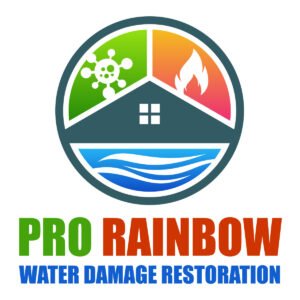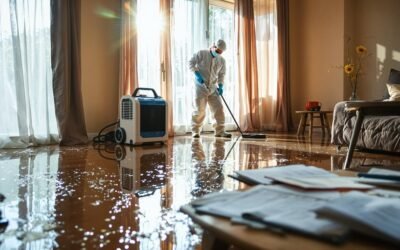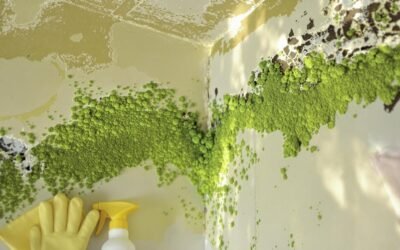Filing a water damage claim can be tricky since coverage varies based on the damage type. Standard homeowners insurance typically covers issues like burst pipes, but flood damage usually needs separate flood insurance. You should assess the source of the damage and review your policy details, including any exclusions. Documenting the damage thoroughly can strengthen your claim. Start the process by notifying your insurer and gathering evidence, such as photos and repair estimates. Understanding these steps is vital for successful claims management, and you might find insightful details that could aid your situation further on this topic.
Key Takeaways
- Homeowners insurance typically covers water damage from plumbing issues, but flood damage requires separate flood insurance.
- Coverage specifics vary by policy; review your individual policy to understand what types of water damage are included.
- Documentation of the damage, including photos and repair estimates, is essential for supporting your claim.
- Notify your insurance company promptly to initiate the claims process and maintain clear communication throughout.
- Be aware of common exclusions, such as mold damage, which may affect your claim's approval and coverage amounts.
Understanding Water Damage Types
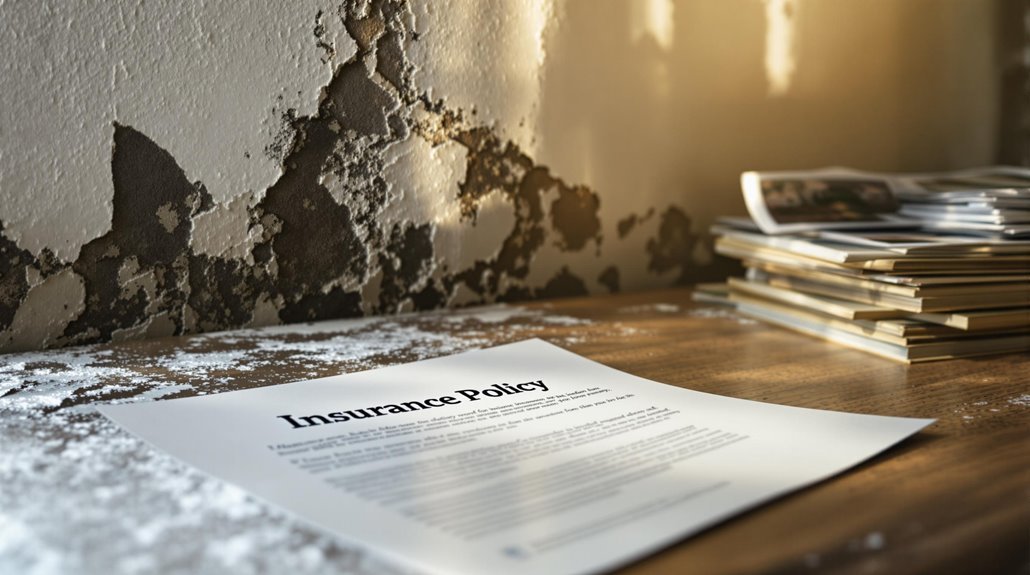
When it comes to filing a water damage claim, understanding the different types of water damage is vital, as each type can significantly impact your claim process and coverage. Flood damage, often resulting from natural disasters, is typically covered under specific flood insurance policies rather than standard homeowners insurance. On the other hand, plumbing issues, such as burst pipes or leaks, usually fall under homeowners insurance, but coverage can vary based on the policy details. It's important to assess the source and nature of the water damage to determine the appropriate coverage. Documenting the damage thoroughly will help support your claim, ensuring you navigate the claims process effectively and maximize your potential compensation. Additionally, professional restoration can prevent further damage and enhance the chances of successful claim approval.
Homeowners Insurance Basics
Understanding homeowners insurance is essential for safeguarding your property and finances, especially in the event of water damage. Home insurance typically covers a range of perils, but the specifics depend on your policy details. When reviewing your policy, look for coverage types such as dwelling, personal property, and liability. Each section defines what's protected and the limits of coverage. It's also important to know your deductible, as this will affect your out-of-pocket costs during a claim. Furthermore, familiarize yourself with any endorsements or riders that may improve your coverage. By grasping these fundamentals, you can make knowledgeable choices about your home insurance, ensuring you're adequately protected against potential water damage incidents. Additionally, understanding the types of water damage covered by insurance can help you navigate your claims process more effectively.
Common Coverage Exclusions
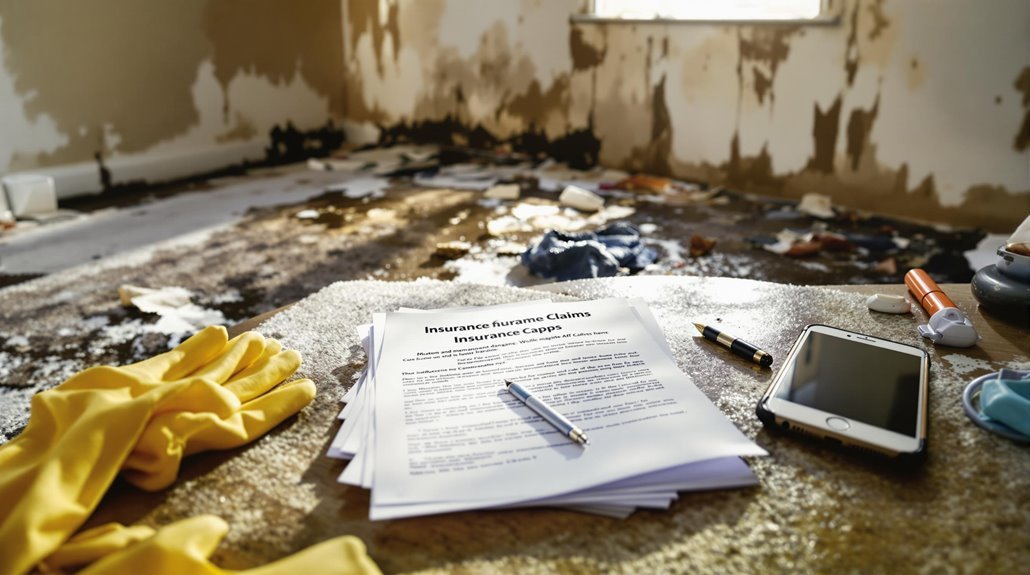
Many homeowners are surprised to uncover that their insurance policies contain common exclusions related to water damage. One major exclusion is flood damage, which typically requires separate flood insurance. If your property experiences water damage from a flood, your standard homeowners insurance won't cover it, leaving you vulnerable without additional coverage. Another significant exclusion involves mold damage. Most policies limit or exclude mold-related claims unless you can prove it resulted from a covered peril, such as a burst pipe. Regular maintenance is essential, as neglect can lead to mold growth, further complicating your claim. Understanding these exclusions helps you prepare and safeguard against potential financial losses because of water damage.
Steps to File a Claim
Filing a water damage claim involves a series of structured steps to guarantee you receive the compensation you deserve. Start by notifying your insurance company to initiate the process. Gather all necessary claim documentation, including photos of the damage and any repair estimates. Document your conversations with your insurer to maintain clear insurance communication.
Here's a simple table to help you track your steps:
| Step | Action |
|---|---|
| 1. Notify Insurer | Call or email your insurance company |
| 2. Gather Documentation | Collect photos and repair estimates |
| 3. Maintain Communication | Keep notes of all interactions |
Following these steps will streamline your claim process and improve your chances of a successful outcome.
Documenting the Damage
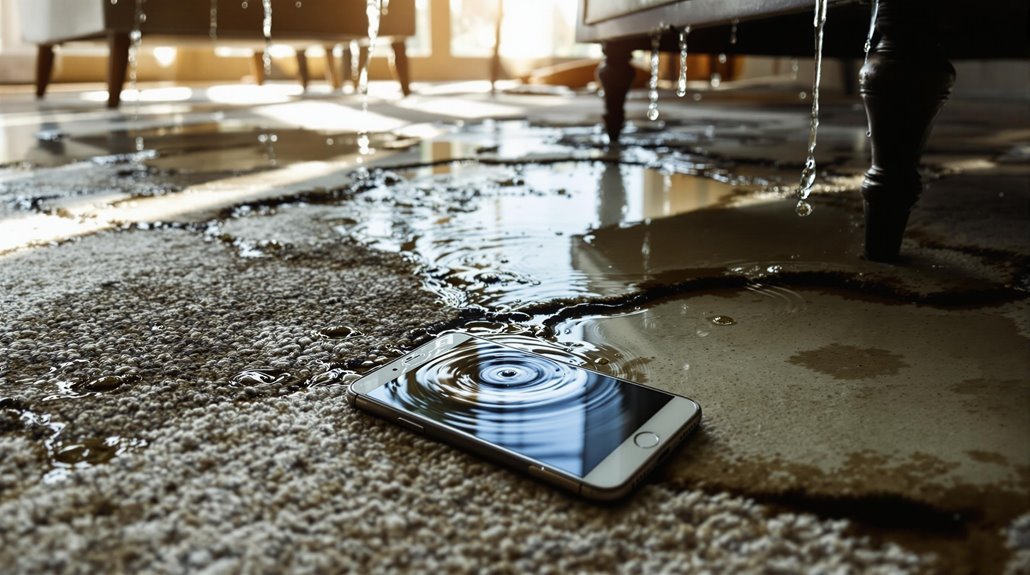
When it comes to documenting water damage, having a systematic approach can make a significant difference in your claim process. Start with a thorough damage assessment; this means inspecting all affected areas, including walls, floors, and belongings. Create a detailed inventory of damaged items, noting their condition and estimated replacement costs. Photographic evidence is vital, so take clear, timestamped photos from multiple angles. Ascertain you capture the extent of the water intrusion and any visible mold. If possible, document the source of the damage, as this can support your claim. Finally, maintain records of any repairs or remediation efforts. This organized documentation not only strengthens your claim but likewise streamlines communication with your insurance provider.
Working With Insurance Adjusters
Steering the process of working with insurance adjusters can considerably influence the outcome of your water damage claim. Effective adjuster communication and strong negotiation strategies are key to achieving a favorable result. Here are four crucial steps to help you navigate this process:
- Prepare Documentation: Organize all relevant documents, including photographs and repair estimates.
- Establish Rapport: Build a professional relationship with the adjuster to promote open communication.
- Stay Informed: Understand your policy's coverage limits and exclusions to address any potential issues proactively.
- Be Persistent: Don't hesitate to follow up regularly, ensuring your claim remains a priority.
The Claims Process Timeline

Understanding the claims process timeline is essential for ensuring your water damage claim is handled efficiently. The claims duration can vary based on multiple factors, including the severity of damage and the insurance company's workload. Typically, you can expect the following stages in claim processing:
| Stage | Duration | Key Actions |
|---|---|---|
| Initial Report | 1-3 days | Submit claim and documentation |
| Adjuster Assessment | 3-7 days | Adjuster reviews damage and estimates |
| Approval Process | 1-2 weeks | Insurer evaluates and approves claim |
| Payment Disbursement | 1-2 weeks | Funds issued for repairs |
Being aware of these stages helps you set expectations and follow up effectively, ensuring a smoother claims experience.
Tips for a Successful Claim
To guarantee your water damage claim is successful, it's crucial to be proactive and organized from the start. Here are some tips that can boost your claim preparation:
- Policy Review: Familiarize yourself with your insurance policy to understand coverage limits and exclusions.
- Document Damage: Take clear photos or videos of all affected areas and items before making repairs.
- Gather Receipts: Keep records of any expenses related to the water damage, including repair costs or temporary accommodations.
- Contact Your Insurer Promptly: Notify your insurance company as soon as possible to initiate the claims process and avoid delays.
Following these steps can greatly improve your chances of a successful water damage claim.
Next Steps After Approval

Once your water damage claim is approved, it's time to take decisive steps to restore your property and manage any financial implications. First, review your claim settlement details closely to understand what costs are covered. This clarity will help you budget effectively for the repair process. Next, gather estimates from licensed contractors to assess the full extent of repairs needed. Confirm these estimates align with your settlement amount. Once you select a contractor, maintain clear communication throughout the repair process to guarantee work meets your expectations. Document all repairs and expenses meticulously, as this information may be essential for future claims or disputes. By staying organized and proactive, you can navigate the aftermath of water damage with greater confidence.
Conclusion
Steering a water damage claim can feel like sailing through stormy seas, but understanding your coverage can be your lighthouse. By knowing the types of water damage, common exclusions, and the claims process, you can better protect your home and finances. Documenting the damage meticulously and working closely with adjusters will help you weather the storm. Once you have approval, take swift action to restore your home, ensuring you're prepared for whatever comes next.
